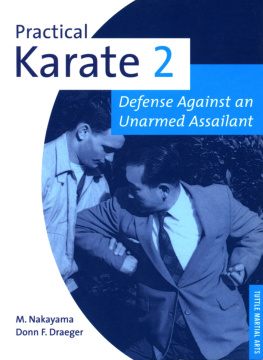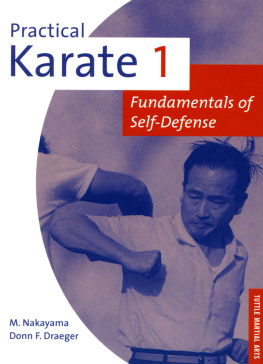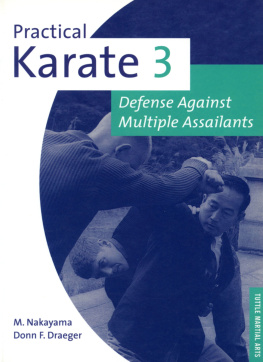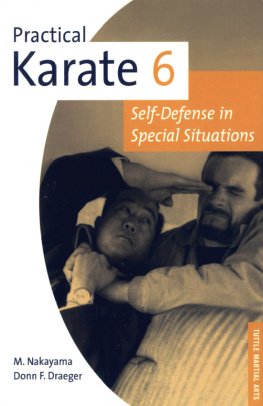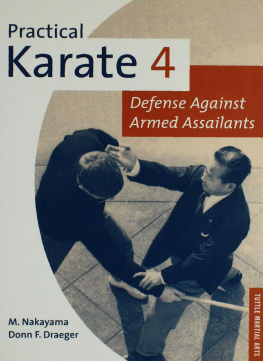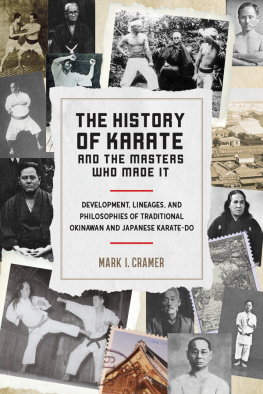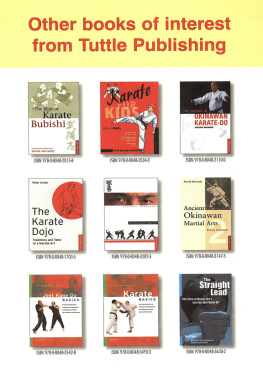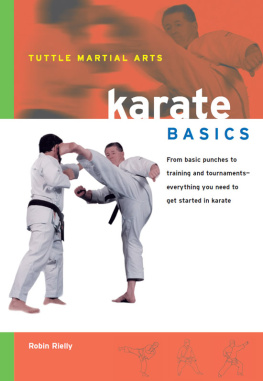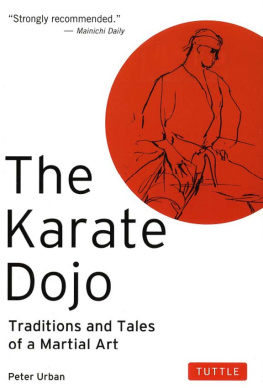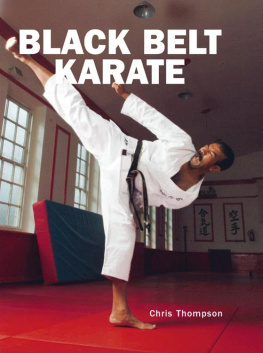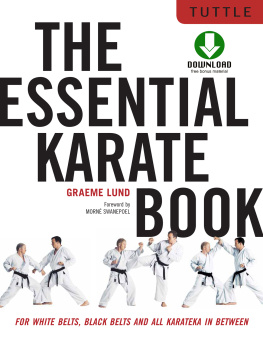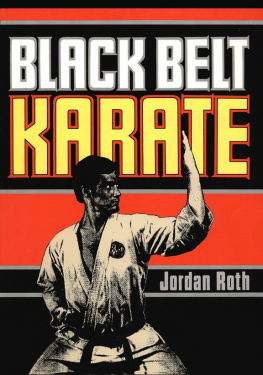M. Nakayama
Donn F. Draeger
Disclaimer
The adoption and application of the material offered in this book is at the reader's discretion and sole responsibility. The Author and Publisher of this book are not responsible in any manner whatsoever for any injury that may occur indirectly or directly from the use of this book. Since the physical activities described herein may be too strenuous in nature for some readers to engage in safely, please consult a physician prior to training. The specific self-defense practices illustrated in this book may not be justified in every particular situation or under applicable federal, state or local law. Neither the Author or the Publisher make any warranty or representation regarding the legality or appropriateness of any technique mentioned in this book.
Copyright 1963 by Charles E. Tuttle Co., Inc. with editorial offices at
364 Innovation Drive, North Clarendon, VT 05759 U.S.A.
Copyright renewed 1991 by Charles E. Tuttle Co., Inc.
All rights reserved. No part of this publication may be reproduced or utilized in any form or by any means, electronic or mechanical, including photocopying, recording, or by any information storage and retrieval system, without prior written permission from Tuttle Publishing.
Library of Congress Catalog Card Number: 98-87646
ISBN: 978-1-4629-0517-1 (ebook)
DISTRIBUTE D BY
NORTH AMERICA
Tuttle Publishing USA
364 Innovation Drive
North Clarendon, VT 05759-9436
Tel 1 (802) 773 8930
Fax 1 (802) 773 6993
SOUTHEAST ASIA
Berkeley Books Pte. Ltd.
61 Tai Seng Avenue, #02-12
Singapore 534167
Tel: (65) 6280 1330
Fax: (65) 6280 6290
Email: inquiries@periplus.com.sg
Web site: www.periplus.com
JAPAN
Tuttle Publishing Japan
Yaekari Building 3rd Floor, 5-4-12
Osaki Shinagawa-ku,
Tokyo 141-0032
Tel: 81 (03) 5437 0171
Fax 81 (03) 5437 0755
First edition
07 06 05 04 03 02 01 00 99 98 10 9 8 7 6 5 4 3 2 1
Printed in Singapore
TABLE OF CONTENTS
|
|
|
| Chapter One: | |
| WristSleeve Seizures; Tackling; NeckLapelBelt Seizures and Striking; Headlocking; Kneeing; Kicking. |
| Chapter Two: | |
| CollarSleeve Seizures; HammerWristFull Nelson Locks; MuggingBear HuggingChoking; Striking. |
AUTHORS' FOREWORD
THIS BOOK is written for every male and brings to him a chance to improve his personal self-defense abilities without engaging in the severe discipline and dedication to daily training required by classical karate. It is not intended to be an exhaustive survey of karate methods, but it does set down the "meat" necessities for practical application. In choosing this book's methods and techniques, careful consideration was given to the practice time available to the average person. The many complex movements of classical karate can never be efficiently learned by the casual practitioner who, by less than daily training, can never attain the flexibility and reflex action essential to the acrobatic movements of a karate expert. Therefore, a simplified, direct method of self-defense is necessary.
You will notice that the arrangement of this text is a categorized collection of self-defense situations and recommended karate responses. Here you can readily find common self-defense problems and an efficient response thereto. If you have already studied and practiced the necessary karate fundamentals found in Book one of this series, the situations in this volume will be easy to learn. Otherwise, after reading about the situation and response herein, you may find it necessary to turn to Book one to find the movements and exercises which are necessary to make these responses work effectively.
All methods described in this book are workable karate self-defense responses based on facing an unarmed assailant. The subjects of self-defense against an armed assailant or multiple assailants are not treated, since they are highly specialized and beyond the scope of this book. These topics will be covered in Books three and four. Likewise, self-defense for females is not included due to the limitations of their physical abilities and restrictions of dress. This subject will be covered in Book five of this series.
The reader is reminded that even mastery of what is outlined in this text will not make him invincible in personal encounters, but it will certainly better prepare him should defense of his life or that of others become necessary. He is further reminded that mere reading, together with one or two rehearsals of each response in this book, will not produce results.
The authors are indebted to the Japan Karate Association, Tokyo, japan, for the use of their facilities and hereby acknowledge with pleasure the assistance of those members and officials who have made this book possible. Additional thanks is due to the excellent photographic skills of Akira Kasahara, which has given this book its illustrations, and to James S. Bregman, a student of combative arts who posed as the "assailant" in the illustrations.
Tokyo, Japan

PREFACE
KARATE is a martial art developed by people who were prohibited the use of weapons, thus making it a defensive art. When one is attacked, the empty hands (which the word karate implies) are quite sufficient to defend oneself if one is highly skilled in the art. However, to become highly skilled takes exacting discipline, both mental and physical. The main purpose of this series of six books is to avoid the advanced techniques of karate which require many years of study and instead to describe simplified karate technique as easy-to-learn responses to typical self-defense situations.
Karate is highly esteemed as a sport, self-defense, and as a physical attribute for athletics in general. It is becoming increasingly popular in schools, offices, factories, law enforcement agencies and the armed services, varying in degree as required by the respective wants and needs.
In response to the many requests for treatment of karate purely as a defensive system, it is hoped that the information contained in this series of six books will be more than sufficient to meet these requests. In conclusion, if readers of this series of books will fully understand the principles and ideals of karate, taking care to use its techniques with discretion, they will reflect great credit to this magnificent art.

THE FIRST and most complete and authoritative text on karate in the English language, titled Karate: The Art of "Empty Hand" Fighting, by Hidetaka Nishiyama and Richard C. Brown, instructor and member of the Japan Karate Association respectively, made its appearance in 1960. It presents karate in its three main aspectsa healthful physical art, an exciting sport, and an effective form of self-defense. As such, it is considered the standard textbook of the Japan Karate Association and adequately serves both as a reference and instructional manual for novice and expert alike.

